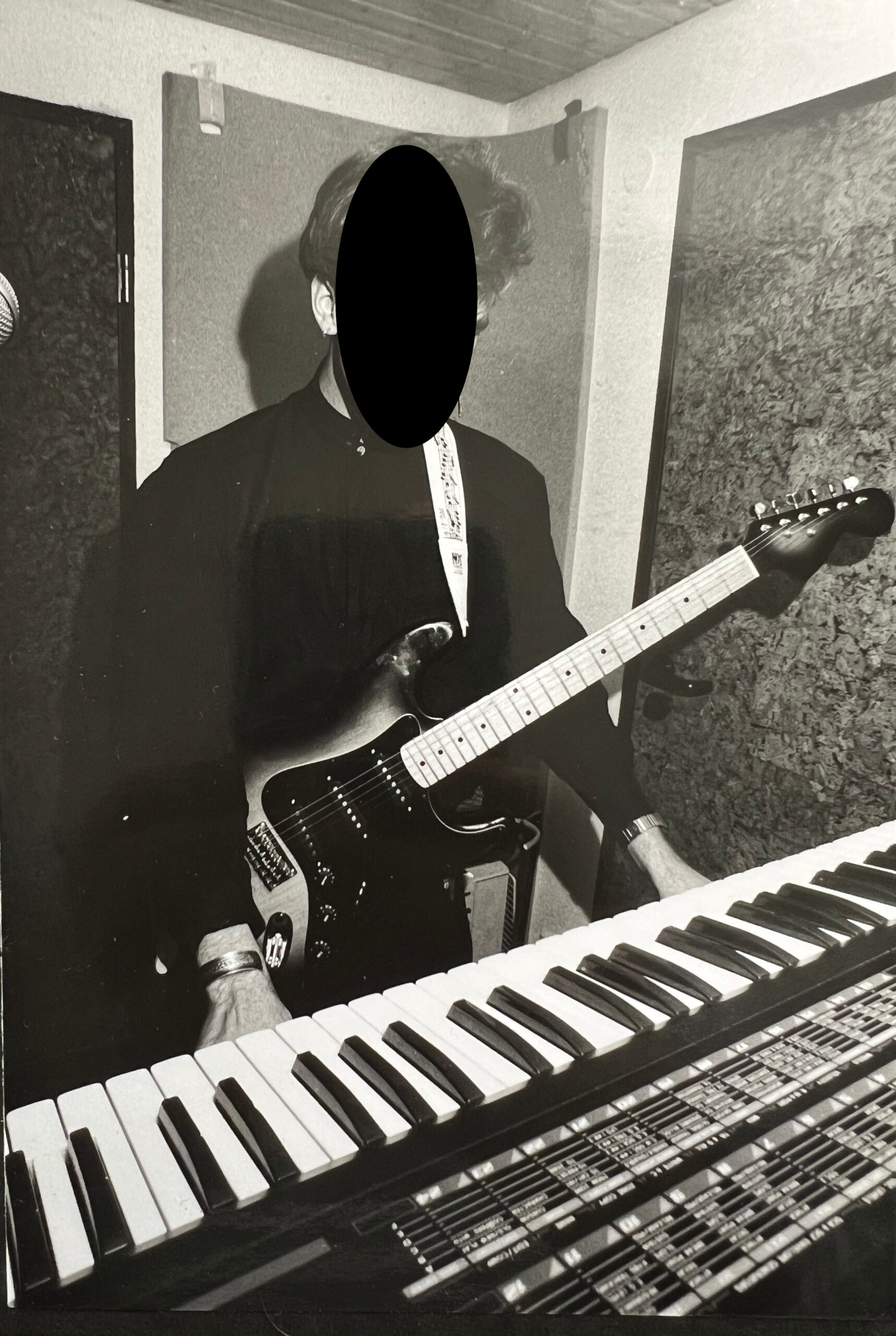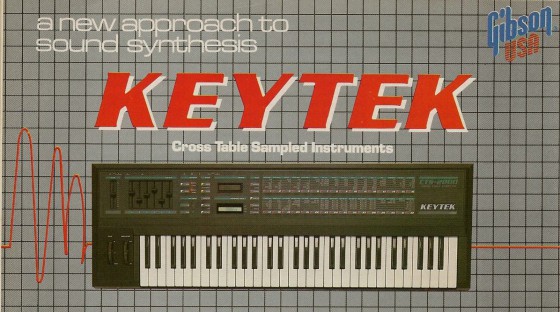In the late 80s, I decided to spend serious money on my first serious synthesizer. Unfortunately, I did not have any money, so I started scouting the ads and mailing lists of lot sellers. There was this one company that, obviously, had good connections to the dying Italian synth industry, and I clearly remember the magnificent Elka Synthex on top of one of those leaflets, a true monster of an analog synth, somewhere on the path between “hopelessly old-fashioned” and “awed classic”, on sale for just over 3000 Deutsche Mark, if I remember it correctly.
I ended up spending 1500 Marks on another Italian Synth: The Keytek CTS-2000 from Siel, later bought by Gibson, even later bought by Roland just to close them down. [Update, 28-May-17: Interesting additional info about what became of Siel after the Keytek is to be found in the comment by microbug.]
From today’s perspective, this machine was not much of an improvement over my previous means of sound generation, the Casio CZ-101, a digital synth with its very own character. But then, the CZ seemed unbearably cheap and nonsensical to me, with its small keyboard, and its four-voice limit. The CTS-2000, on the other hand, was an eight-voice affair with a proper, velocity-sensitive keyboard. And the technology! Sampled waves! Dynamic wave manipulation! Multitimbrality! Sliders for real-time parameter control! Six-stage envelope generators! And! Analog!! Filters!!!
A great concept. There was, to quote another classic from the era, just one tiny little flaw.
There were a few questionable decisions made in the design, as you can read here. It also lacked the processing power to do what it tried to achieve; its TMS-7002 brain was too weak. But the worst thing was: The synth sounded horrible. What I had hoped for was classic analog punch with a digital, modern twist. What I got was a dull third-rate ROMpler. One of the best sounds was no analog pad but a sampled ripoff of a DX-7 slap bass sound. Despite its analog filters, the sounds were thin and harsh, and even the metallic sounds did not shine but came across flat and dull. All high frequencies seemed to be missing.
Dull by design – the central flaw
I tried to make up for the lack of overtones by buying a small enhancer, a device meant to generating additional overtones, and it sort of helped with the piano sounds. But the overall sound remained disappointing, and later, I realised what the problem was: the output circuitry dulled down the sound. A crude and uninteresting low-pass filter removed all signs of life from the signal.
Thinking about it, this is due to the limited technology. When you work with samples, you get quantization noise – the difference between the original wave and the wave generated with, say, an 8-bit resolution. [EDIT: Thanks to a comment by Mikkel Karlsen I learned that the Keytek was built around two SGS M114A chips, digital oscillators based on wavetable ROM, and I suspect that they were used with the lowest possible resolutions of 16 steps per wave cycle, so you would actually get Q-noise three octaves above the pitch frequency of the wave.] Quantisation noise is noise with the frequency of the sample playback, meaning that with lower sampling frequencies, say, around 10kHz, you will get an audible hiss in the signal. But the feeble hardware is incapable of high sampling frequencies. Think of it as a permant, built-in bitcrusher.
The designer seem to have feared that noise, so they added the low-pass filter to the outputs. I actually quite liked it, so I removed a capacitor from the circuit and killed the filter. It sounded a lot better to me after that.

It’s October 2024, and I just discovered a couple of photos proving that I actually played that thing.
Moving on
Still, the Keytek remained an uninspiring machine – and I was really glad to sell it and to move on to a really decent FM synth, the Casio VZ-1. (You see, I’ve got a soft spot for underdogs.) And all the analog warmth I’d ever need soon came from my Matrix-1000 – the one that only recently has undergone brain surgery. And the CTS-2000 went, never to return.
I had all but forgotten the Keytek, but rediscovered it while doing a lot of research on the Matrix 1000’s peers, the generation eventually killed of by the DX-7 and the D-50: 8-bit machines with an analog heart like the Polysix or the Elka EK-22 (another machine that I could have ended up with, and that would have made me much, much happier). These machines keep intriguing me, and although there is quite a good argument to be made that they were closer to what we search in creating sounds – I urge you to read Bob Weigel’s thoughts on the age of Analog and how it ended – I guess it’s just nostalgia, a longing for the time when the world was great and the technology was a marvel.
So I’m remembering the Keytek with fondness and a lot of sympathy for its engineers. I would never take it back, though – even nostalgia has its undisputable limits.
Verwandte Artikel:
- A Pre-Filter Booster Stage for Jenny (Monday, 5. November 2018; Schlagworte: analog synthesizer, DIY, Jen SX-1000, Modding, monosynth, synthesizers)
- OMG OMG I actually played that thing! (Thursday, 3. October 2024; Schlagworte: analog synthesizer, CTS-2000, Keytek, Synthesizer, hybrid synthesizer)
- Yay! I’ve bought a DIY Minimoog. (And Jenny is going to love it!) (Thursday, 1. December 2022; Schlagworte: Moog, Synthesizer, vintage, Makeproaudio Dino Park, Roland SE-02)

Roland did not close down SIEL then, the staff and factory became Roland Europe, which developed the E and G series arranger keyboards, the A-70 and A-90 master keyboards and many other instruments. They closed it down now, but this was still not the end, since the remaining staff bought the facilities and became Dexibell, the new digital Piano manufacturer.
Thanks a lot for the additional info, that’s interesting! (I’ll update the text. If you happen to have a source at hand, I could link to that as well.)
Sorry that it took me so long to answer this – I simply forgot until I came across it again.
Here is a link from an Italian site about the foundation of Dexibell with finances from Proel. There also was said that the factory exists since 1976, but the name SIEL is not mentioned, but it is exactly this factory.
http://www.italy24.ilsole24ore.com/art/business-and-economy/2015-12-16/roland-fisarmoniche-131824.php?uuid=ACU1tduB
Thanks for the great information :D .. i just bought a Solton M160.. that is a rack preset version of this synth, but same engine as far as i can understand. And yes it does sound like all the topend is missing from the sound.. so if you have any info on how to remove the lowpass filter from the output i would be very intrested :)
Oh my – this has been so long ago. AFAIK I did it by removing a capacitor somewhere in the output circuitry, but I have no longer a clue which one – it was pretty much trial-and-error, and the result was still underwhelming.
Pretty interesting clue about the M160 having the same engine (thank you!); reading up on it, I saw the post over at Matrixsynth referring to the Keytek’s and M160’s common use of the SGS M114A chip – good to see here. The worst possible quality is a 16-step waveform which would make for some nasty quantization noise at 8x the base frequency of the wave, so my theory about the output filter sounds even more convincing to me. So maybe fire up an oscilloscope and try to find an unfiltered tap for the output signal? :)
Nice article . I read it with fondness as well. I recall one of my first synths was a Kawai SX240. Now it is sought after, but that doesn’t mean it was all that good sounding form the start.
Anyways, thank you for the work on the Matrix 1000. The upgrade a while ago went flawless. Since then I have written a controller for the Matrix 1000 using an Electra One (yes .. no computer needed while tweaking :-) ), so now I can change the sound in real time (indulging the Matrix responsiveness) but also view how the patches are made up, and store them afther changing them, bacn on the Matrix 1000. The combination of the new firmware with an Electra One controller is fantastic.
Can you please show which two capacitors to remove on cts2000 to remove lpf?? Thank you!
I can’t. I haven’t been in possession of a CTS-2000 for over thirty years now.
thank you. i would like to post image of the board if it helps.
https://postimg.cc/fkcwF9fs
Not that much, unfortunately. For one, I would strongy discourage cutting out parts from your vintage synth just because some random geezer on the Internet says, yes, maybe you can. Especially if that geezer has no access to a schematic, PCB layouts, or measurements.
The one thing that I CAN tell you is that AFAIR this is not the board I modified – there is, I seem to remember, a small daughter board under the volume slider containing output op-amps, and the aforementioned filter. Look if you can find someone with an oscilloscope, and try to find an unfiltered signal you can tap.
The offending filter is on the front panel board, near where the pitch and mod wheels connect. If you see op amps (2 5532 ICs, I think), then you’re in the right spot. It’s more than two capacitors. I traced out the circuit and found that it’s a high order filter with a cutoff frequency around 7.3 kHz. For each channel, remove 5 capacitors (5.6 nF, 10 nF, 820 pF, 15 nF, 330 pF). Then the filter circuit will just be a unity gain buffer. It also helps to adjust the VCF trimpots a little so that the maximum cutoff frequency is just out of the audible range. This will change the sound of the presets somewhat (who cares? they’re crap anyway), but it doesn’t significantly affect the low end of the cutoff frequency range.
Yet another link for anybody finding this via Googling “CTS-2000”: This post from 2011 – which I accidentally found scrolling through ancient tweets – calls it “a true gem in sound and a prime example of bad design.” I tend to disagree strongly with the first verdict, and to agree with the second.
Pingback: Fixing a Polysix. A Polysix! - untergeekuntergeek
Pingback: OMG OMG I actually played that Keytek CTS-2000! - untergeek[:]untergeek